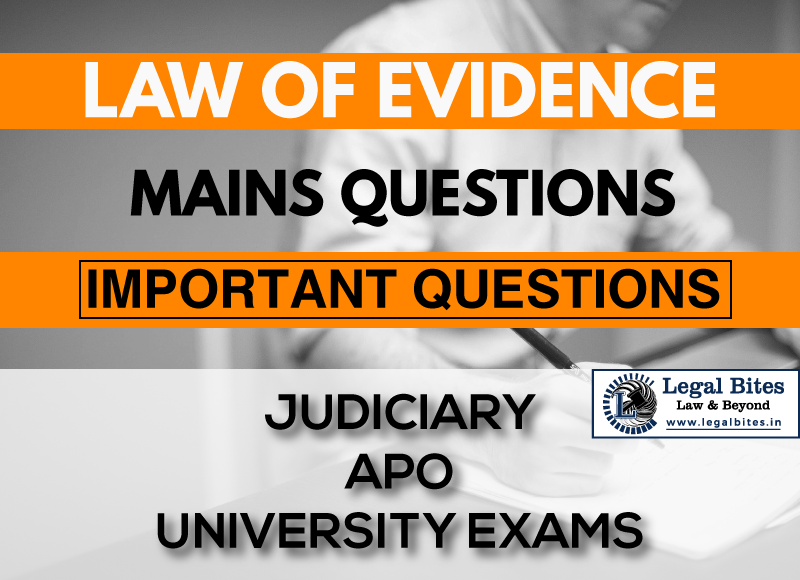Part of Res gestae | A, after learning that C had been murdered, went to the spot and found that the body of C was being taken to the house of C by four persons who told him that B had murdered C and had run away. Does the statement of four persons form part of Res gestae?
Question: Part of Res gestae | A, after learning that C had been murdered, went to the spot and found that the body of C was being taken to the house of C by four persons who told him that B had murdered C and had run away. Does the statement of four persons form part of Res gestae?… Read More »

Question: Part of Res gestae | A, after learning that C had been murdered, went to the spot and found that the body of C was being taken to the house of C by four persons who told him that B had murdered C and had run away. Does the statement of four persons form part of Res gestae? [U.P.C.J. 1985, EIR.J.S. 1999] Find the answer to the mains question only on Legal Bites. Part of Res gestae | [A, after learning that C had been murdered, went to the spot and found that the body of C was...
Question: Part of Res gestae | A, after learning that C had been murdered, went to the spot and found that the body of C was being taken to the house of C by four persons who told him that B had murdered C and had run away. Does the statement of four persons form part of Res gestae? [U.P.C.J. 1985, EIR.J.S. 1999]
Find the answer to the mains question only on Legal Bites. Part of Res gestae | [A, after learning that C had been murdered, went to the spot and found that the body of C was being taken to the house of C by four persons who told him that B had murdered C and had run away. Does the statement of four persons form part of Res gestae?]
Answer
Section 6 of the Indian Evidence Act which provides for relevancy of facts forming part of the same transaction states as-
Facts which, though not in issue, are so connected with a fact in issue as to form part of the same transaction, are relevant, whether they occurred at the same time and place or at different times and places.
This section admits those facts the admissibility of which comes under the technical expression res gestae [i.e. the things done (including words spoken) in the course of a transaction], but such facts must “form part of the same transaction”. The statement uttered or act done must be a spontaneous reaction of the person witnessing the crime and forming part of the transaction. The bystanders’ declaration must relate only to that which came under their observation.
The declaration must be substantially contemporaneous with the fact and not merely the narration of a prior event. Applying this to the facts of case Rajan v. State of Kerala, 1992 Cr LJ 575 Ker before it in which the witnesses rushed to the scene of the crime on hearing the sound of an explosion and heard from the mouth of the bystanders as to what had happened, the Kerala High Court has held that the statement was not a part of the transaction
In Mahendra v. State of M.P. (1975) it was held that statement of a person who had come afterwards to the effect that persons at the spot were saying that accused had killed the deceased would not be admissible as it would be only hearsay.
The Apex Court in the case of Sawal Das v. State of Bihar AIR 1974 SC 778, has observed that all spontaneous statements in some way connected with the main transaction are not admissible, the statement is not admissible under section 6 only because it is uttered in course of the transaction, while no doubt the spontaneity of statement is a guarantee of the truth, the rationale for its admissibility under Section 6 is that it is part of the same transaction and not merely because it is spontaneous.
In the present case, A had gone to the spot after the event was over and also, after coming to know that C has been murdered and when he reached the spot, the deceased was being taken to his house by four-person, by one of them, he was informed that B had murdered C. Fact that murder of C had taken place and A came to know about that and then reached the spot and after reaching at the spot he was informed by four persons there that B has committed the crime, is not so connected with each other as to form the same transaction and thus his evidence is not admissible under section 6 of Evidence Act.
Important Mains Questions Series for Judiciary, APO & University Exams
- Law of Evidence Mains Questions Series Part-I
- Law of Evidence Mains Questions Series Part-II
- Law of Evidence Mains Questions Series Part-III
- Law of Evidence Mains Questions Series Part-IV
- Law of Evidence Mains Questions Series Part-V
- Law of Evidence Mains Questions Series Part-VI
- Law of Evidence Mains Questions Series Part-VII
- Law of Evidence Mains Questions Series Part-VIII
- Law of Evidence Mains Questions Series Part-IX
- Law of Evidence Mains Questions Series Part-X
Admin Legal Bites
Legal Bites Study Materials correspond to what is taught in law schools and what is tested in competitive exams. It pledges to offer a competitive advantage, prepare for tests, and save a lot of money.
